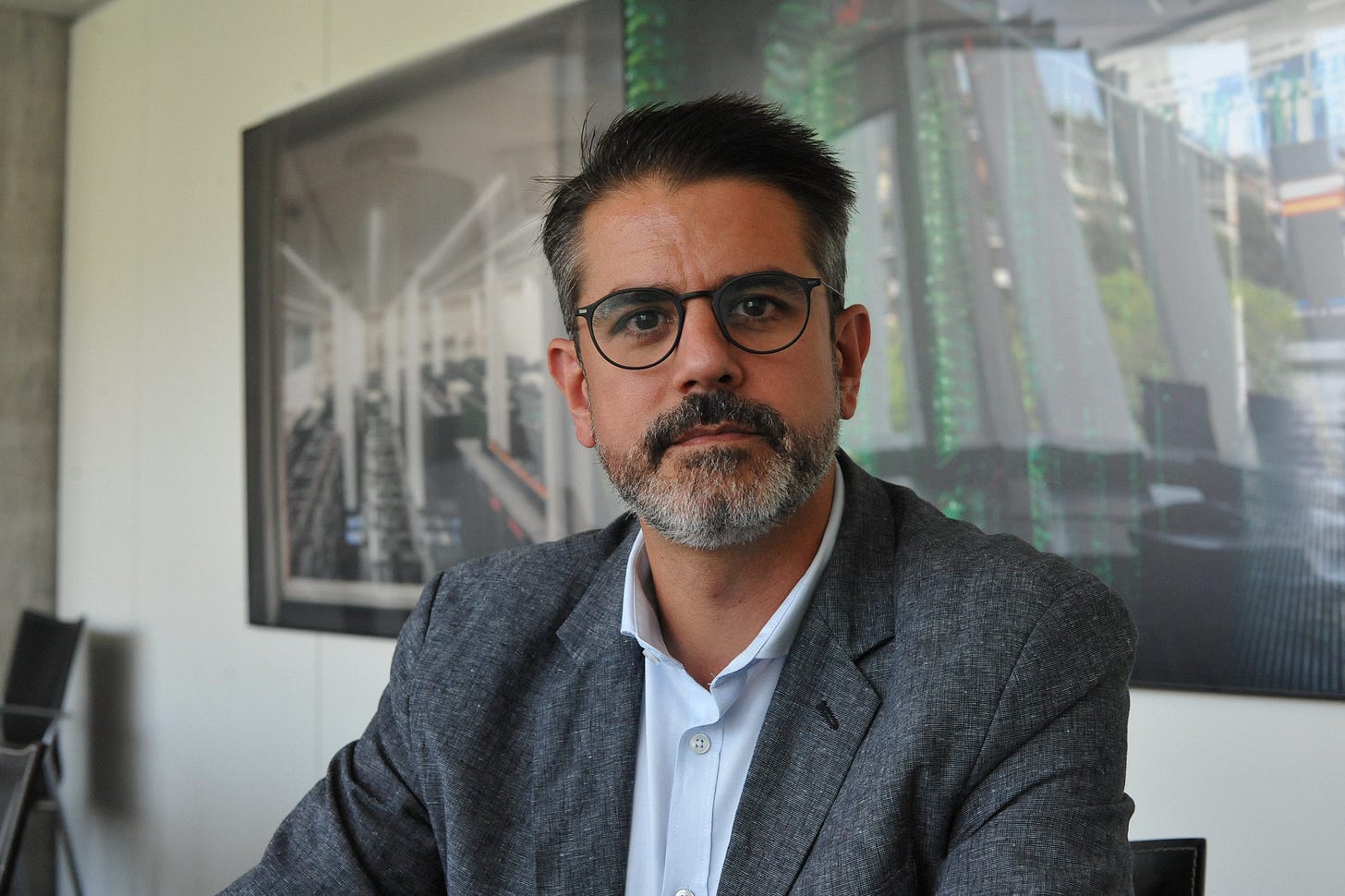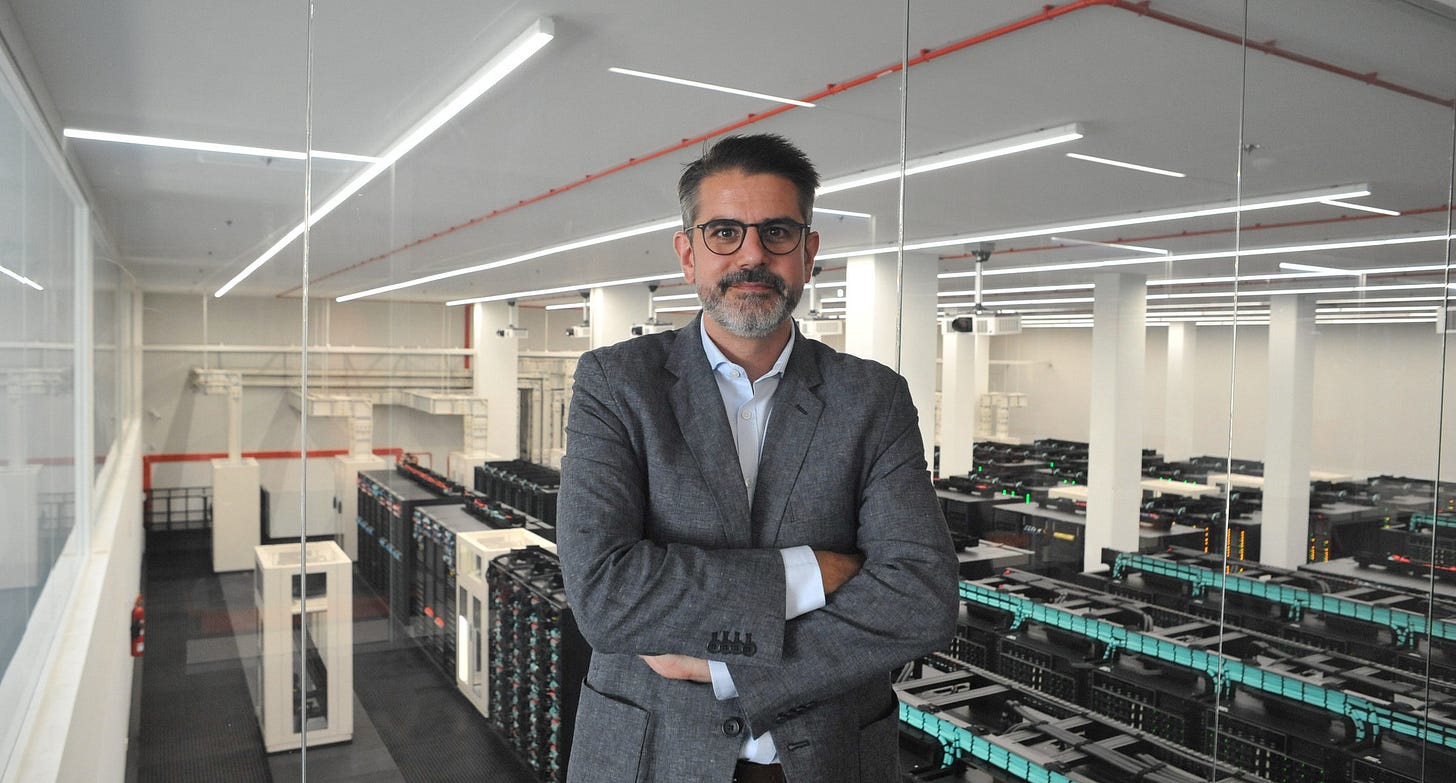🔥 Cristian Canton, New Associate Director of the Barcelona Supercomputing Center 💡 “MareNostrum 6 by 2029 must feature European technology”
🚀 “The free Spanish and Catalan ChatGPT is now mature. We’re improving it and it’s already being used and tested in specific areas”
🌍 “Catalonia will be one of Europe’s main players. We will have the BSC, the AI Factory, and the Móra la Nova gigafactory”
“Europe realises that dependence on Trump’s whims leaves it in an awkward position”
“We will see quantum computing with AI, and I think the next 20 years will be extremely interesting”
“Generative AI has a positive impact because people have become more critical. There’s no need to be afraid.”
Cristian Canton, the new associate director of Spain’s premier infrastructure for artificial intelligence and a cornerstone of European sovereignty—the Barcelona Supercomputing Center— succeeds Josep Maria Martorell after a decade of growth with MareNostrum 4 and 5. Born in Terrassa in 1980, Canton arrives at BSC following eight years as head of AI at Meta in the U.S., five years as a researcher at Microsoft in the U.S. and Canada, and a brief stint at Vicon working in film AI. With a PhD in computer vision from UPC and expertise in machine learning and AI systems security, he has worked at Facebook and Instagram combating disinformation, election manipulation, child protection, and terrorism.
Are you back in Catalonia to live more calmly and be close to home, or is the BSC opportunity more about logical career progression?
Both factors. After many years in Canada, the U.S., and the U.K., my wife and I agreed: “Someday we must return.” And there was the challenge of coming back and doing something interesting. Then BSC contacted me, and I said, “Wonderful.” It fits me perfectly. I wanted to work for my country and contribute to making Catalonia, Spain, and Europe pioneers in AI, supercomputing, and AI‑driven science. It’s a logical career step. I’ve always worked in AI for good and to grow societal potential.
Working for the country and making BSC a sovereignty infrastructure—does that mean Catalan, Spanish, or European sovereignty?
BSC represents more than 50 countries. It’s about doing science here in Catalonia, Spain, and Europe. With the current geopolitical context, achieving sovereignty is crucial—otherwise you depend on others. We depend heavily on American and Asian chipmakers. It would be fantastic to have chips made in Spain or Catalonia. There is also dependence on AI developed outside Europe. Building AI with European values is a key challenge. BSC is critical in the sovereignty race. We’re one of many European players pushing forward. I’m hopeful Europe will attain a stronger technological position.
Your arrival aligns with the bid for the Móra la Nova AI gigafactory. Is it like winning the lottery?
Actually, there are three projects. First, BSC is a major European supercomputing infrastructure for science and AI. Then comes the AI Factory, already approved, which will offer tools allowing external companies and public administrations to use resources via public calls—supporting SMEs to adopt AI quickly. Lastly, there's the Móra la Nova gigafactory, which, if awarded, will enhance technological sovereignty and deliver AI services to large enterprises and administrations. Currently we rely on Amazon, Google, etc. If successful, Catalonia and Spain would become top European players—thanks to BSC, the AI Factory, and this gigafactory. We will collaborate across Europe, and we’re building a strong foundation for technological sovereignty.
Will there be too many companies or not enough, hence a selection process?
The AI Factory is still being built. We’re taking initial steps to understand how to respond to requests like “I want to build a model to classify tree leaves.” Some already have models; others are starting from scratch. There is strong demand for compute hours and services. It’s ideal—the machine should run 24/7. We expect high usage, leading to job creation, new SME capabilities, startups, and potentially impacting Spain’s GDP through well‑timed investment.
When will the AI Factory be operational?
Next year.
Until the Móra la Nova gigafactory is ready, how will you cope with chip needs and Trump-era tariffs?
Great question. The Spanish state’s proposal, in partnership with Telefónica, Catalan firms, and the Generalitat, will feature non-sovereign technology initially. We lack local capacity to manufacture GPUs. That’s why Nvidia is on board—it provides the GPUs. By 2029, MareNostrum 6 must feature European-designed technology. That is our aspiration. Meanwhile, the gigafactory will use Nvidia GPUs. Perhaps the next generation will be European-made. That would be ideal.
Has Trump’s return triggered a positive European reaction?
His comeback has sparked a wake-up call. Rules can change very rapidly now—like never before. Europe realises dependence on one president's whims puts it in a precarious position. Clearly, technological independence is advantageous. It’s a wake-up call to have a long-term plan B. This healthy competition is positive.
What role does BSC play in this European effort?
It’s pivotal. BSC leads the DARE chip design project—a European consortium with an initial €240 million budget. We host a 500‑strong research group working day and night on chip design. We’ve been at it for 20 years.
And in AI?
We’re starting to train models like Alia and Aina for Spanish, Catalan, and other European languages. That positions us well in Europe’s AI landscape. BSC is indispensable in this effort to place Europe firmly in the current geopolitical framework.
Does the Spanish ChatGPT have a release date?
Good question. I have a meeting after this interview to discuss it. We have early versions—it’s mature. We’re improving it. It has begun to be used and tested in some places—pilots in hospitals and public bodies. It's a good investment, because language models encapsulate culture via training data. Models like Llama, Gemini, or ChatGPT are trained primarily on Anglo‑Saxon data, not fully representing European culture. Training models on curated data reflecting European values is critical—it ensures the model embodies a specific culture and values not found elsewhere. This model will balance Anglo‑Saxon models.
Will it be an open, free large‑language model that continues to learn?
Exactly. An open-source, free model accessible for startups or any use. It’s beneficial to make it public. These models require continuous retraining to stay current—with more data. We'll enhance reasoning and support for minority languages. Aina (Catalan), Alia (Spanish and others), and companion models will improve incrementally.
Will Aina and Alia remain competitive as larger models emerge?
It’s about strategy. A LLM is essentially a black box generating inputs and outputs. You can augment it with agent support or retrieval systems. Larger models from big companies may have more resources, but for languages like Catalan, they may underperform. I’ve seen this at Meta: a model can be brilliant in English but weak in Catalan. It depends on coverage. Aina and Alia will address gaps not prioritized by large models. They can be enhanced through partnerships. We don’t always need the largest model. As Bill Gates said: “It’s better to bet on the penultimate trend.” If it works, great. Models from a year ago may already be sufficient, depending on your goals.
That matches the European logic of competing with smaller, more efficient models rather than costly giants.
Absolutely. There’s also small Llama or small Gemini—not just Mistral. First train a big model to get its performance, then research to make much smaller models that maintain capabilities. This iterative process improves technology—it’s not necessary to have an all-in-one model.
What fields will need the AI Factory in coming months or years?
Several: AI for public administrations—to improve citizen services; health—which is critical given global strain; services and human‑AI interactions beyond chatbots; mental health; and quantum computing with AI, which I believe will be extremely interesting over the next 20 years.
Please explain quantum computing.
It’s emerging and widely discussed. It offers technology to solve specific problems that standard computers struggle with. Some AI training algorithms are extremely costly. The question is: “If we used a quantum computer, what could we enhance?” There are exciting research areas. The EU is investing here too—it’s becoming tangible. Five years ago we spoke of “winter,” then generative AI sparked a “eternal spring.” Now, quantum computing has strong ideas. The next 10–20 years will be thrilling. BSC will have a critical role—that’s my hope.
Does frontline optimism contrast with public fear fueled by the media?
There are many dimensions: job market effects, daily life. Like any new technology, it brings benefits and risks. When generative AI emerged, fake news terrified many. Today’s models generate videos even I struggle to detect. But there’s a positive effect: people have grown more critical. We’re verifying information more carefully. It also unleashes creativity in fields like film. During the industrial revolution, horse wranglers feared cars—but then new jobs emerged. With AI we expect new professions. There’s no need to fear—instead, be informed and seek opportunity. They’ll come, and many. Let’s embrace them and see how far we can go—this won’t stop.



